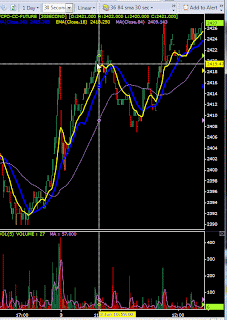FKLI Futures Trading - Bursamalaysia
This will chronicle trading in the FKLI & FCPO futures. If you don't like what you see/read in this blog, just surf away. These opinions are our personal opinions and just a record of our thoughts..."In evolution, it’s not the biggest, the fiercest nor the smartest that survive, it’s the one that changes the fastest.” I.e. the key word is to adapt the trading style to the markets, until it stops working
Monday, June 30, 2014
The World cup and cheating, 10 out of 10 for the perfect dive
Australia v Italy ROund of 16, Germany 2006
Arjen Robben, Netherland v Mexico Round of 16, Brazil 2014
Sunday, June 29, 2014
THOSE WHO KNOW DON'T TELL, THOSE WHO TELL DON'T KNOW
From Stanley Kroll's "Dragons and Bulls"
Someone once said, 'The best way to make a small fortune in financial
speculation is to start with a large fortune.' It is unfortunate, but this
cynical quote is very true, because the vast majority of active specula-
tors, whether in stocks, currency, futures, options or derivatives end
up losing money. Let us examine why this is so, and what we can do
to position ourselves within the small, but winning minority.
In his memoirs, written in 1829, Bourriene recounts an incident in
which Napoleon was asked which troops he considered the best. 'Those
which are victorious, madame,' replied the emperor. I was reminded of
this incident while perusing some notes on the subject of winners and
losers in the investment arena. The Wall Street jamnal of 10 January
1983, printed a survey of 20 senior commodity specialists and their
best investment bets for the first half of 1983. Three points were given
to a first choice, two points to a second choice and one point was given
to a third choice. The ratings were totalled up and the results were
extremely enlightening.
0 Buy copper 18 points
0 Buy gold 16 points
0 Buy foreign currencies 1 5 points
0 Buy stock indexes 14.5 points
0 Buy cattle ~ 1 1 points
0 Buy silver 7.5 points
Some observations bear further consideration. First and most
obvious, all recommendations were on the buy side. Not suprisingly,
this proved a mistake since, of the top six selections, only two of them,
stock indexes and copper, advanced during the six-month period. Of
the remaining four selections, gold and foreign currencies were down,
and cattle and silver just managed a sideways move. And, while all
selections were biased to the long side, the few serious bull markets
for that year, com, soybeans, cocoa, cotton and sugar, were totally
overlooked by the experts. It is noteworthy that copper appears so
consistently on the list. Buy copper was also the second top selection in
the previous survey (second half of 1982) and was the first selection in
the first half of 1982 survey. The actual price action of copper, as well
as the composite decision was mediocre at best during this
year-and-a-half period. The copper market barely managed a broad
sideways move for the entire period: down during most of 1982 and up
during the first half of 1983.
The point of this exercise is to demonstrate how difficult it is, even
for experienced experts, to predict the course of futures prices a mere six
months ahead. The dismal record of these professionals should encour-
age serious speculators to note that the experts are frequently wrong
and that a good technical approach to investment and timing, coupled
with sound money management and a focus on trend following rather
than trend predicting, are really the recommended ways to operate for
optimum success.
There is a similar experience in the stock market between predic-
tions of experts and a random selection of stocks. The Wall Street
journal conducts an ongoing competition, every six months, between
two groups of 'analysts': firstly a panel of expert analysts and brokers
and secondly the 'Dart Throwers,' a group of T/Je Wall Street journal
staffers who randomly throw darts at the journal price page, and 'select'
whichever stocks are hit. One would think that the 'professional
experts' would consistently beat the 'dart throwers,' and by a very wide
margin. But, that just hasn't been the case. Over a period of several
years, the 'experts' have been ahead of the 'dart throwers'; but only by
a narrow margin, at best.
overlooked by the experts. It is noteworthy that copper appears so
consistently on the list. Buy copper was also the second top selection in
the previous survey (second half of 1982) and was the first selection in
the first half of 1982 survey. The actual price action of copper, as well
as the composite decision was mediocre at best during this
year-and-a-half period. The copper market barely managed a broad
sideways move for the entire period: down during most of 1982 and up
during the first half of 1983.
The point of this exercise is to demonstrate how difficult it is, even
for experienced experts, to predict the course of futures prices a mere six
months ahead. The dismal record of these professionals should encour-
age serious speculators to note that the experts are frequently wrong
and that a good technical approach to investment and timing, coupled
with sound money management and a focus on trend following rather
than trend predicting, are really the recommended ways to operate for
optimum success.
There is a similar experience in the stock market between predic-
tions of experts and a random selection of stocks. The Wall Street
journal conducts an ongoing competition, every six months, between
two groups of 'analysts': firstly a panel of expert analysts and brokers
and secondly the 'Dart Throwers,' a group of T/Je Wall Street journal
staffers who randomly throw darts at the journal price page, and 'select'
whichever stocks are hit. One would think that the 'professional
experts' would consistently beat the 'dart throwers,' and by a very wide
margin. But, that just hasn't been the case. Over a period of several
years, the 'experts' have been ahead of the 'dart throwers'; but only by
a narrow margin, at best.
Accordingly, a thoughtful student of financial markets should ask
the question: why are the experts so often wrong and why do so many
traders lose money at speculation? The answers may be circuitous and
are often difficult to pin down. However, it may be constructive to
reflect on what I call, the 'speculators' laments.'
With the exception of my 1975 to 1980 sabbatical, I have spent
most of the past 34 years in a quiet, secluded office, either in Wall
Street, upstate New York or aboard a large motor yacht, with trading
monitor, phones, technical studies and other accoutrements. Consis-
tently, my principal focus has been trying to make big profits on my
favourable positions and to avoid taking big losses on my adverse ones.
I have invariably played a lone hand, and very much by choice, having
learned the benefits of operating independently early on as a Merrill
Lynch account executive in New York in the 19605. The lesson that I
Friday, June 27, 2014
Thursday, June 26, 2014
Tuesday, June 24, 2014
Sunday, June 22, 2014
Tuesday, June 17, 2014
Friday, June 13, 2014
Thursday, June 12, 2014
Tuesday, June 10, 2014
Sunday, June 08, 2014
Saturday, June 07, 2014
Wednesday, June 04, 2014
Tuesday, June 03, 2014
Monday, June 02, 2014
"There is the plain fool who does the wrong thing at all times anywhere, but there is the Wall Street fool who thinks he must trade all the time."J Livermore


From Dragons and Bulls by Stanley Kroll
Introduction and Foreword
The Importance of an Investment Strategy
5 The Art of War, by Sun Tau (circa 506 BC) and The Art of Trading Success (circa AD 1994)
That's the way you want to bet
Long-term v Short term trading
Technicals v Fundamentals
Perception v Reality
Part 1: Winners and Losers
Part 2: Winners and Losers
Sun Tzu: The Art of War
Those who tell don't know, those who know don't tell
Why there is no such thing as a "bad market"
The Secret to Trading Success
The Experts, do they know better?
Risk control and money management
Larry Hite: The Billion Dollar fund Manager
Systems Trading:Kroll's Suggested Method
Buy the Strength Sell the Weakness
Good advice
The 'good bets' business by Larry Hite
Don't lose your shirt
Ed Sykota's secret trend trading system































